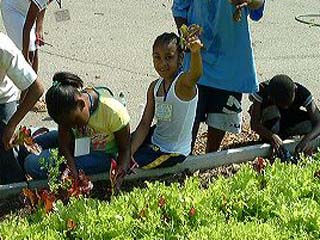 Vast potential: a farm grows in Brooklyn. Photo: Added ValueAs I prepare for five days of announcements next week, when USDA plans to unveil its new “Know Your Farmer, Know Your Food” initiative, the buzz across my desk is about the potential for urban agriculture.
Vast potential: a farm grows in Brooklyn. Photo: Added ValueAs I prepare for five days of announcements next week, when USDA plans to unveil its new “Know Your Farmer, Know Your Food” initiative, the buzz across my desk is about the potential for urban agriculture.
EPA reminds that brownfield moneys can be used to convert polluted land into working farms in inner-city areas. I saw the excellent film “The Garden,” documenting the destruction of the largest community farm in the U.S. (South Central LA) in 2006. Will and Erika Allen are coming to Minnesota again. Over breakfast, friends asked about the potential for urban food production.
I think the potential is enormous, especially in formerly industrial cities, where the big factories are not going to come back, but there are large tracts of vacant land that already have water mains (think irrigation) running under them. Each of these cities spends billions of dollars for food, and can generate significant local income by building the farms and distribution channels needed to cycle that food within city borders. We’ll also need to grow new urban farmers, and tap the excellent skills that many new immigrants already have in growing food.
Hoping the USDA will focus next week on turning urban lands into productive farms, I’ve finished revising a brief resource guide for urban agriculture I handed out at the Urban Extension Educators conference when I spoke there in May. Let me know if this is useful, or how to improve it!
Did you know that forty-one percent of all U.S. agricultural commodities are sold from farms in metropolitan counties?
Were you aware that 55% of the money made from producing farm commodities was made in metropolitan areas in 2007 ($15.7 billion of $28.7 billion)?
Moreover, Department of Defense studies show that Victory Gardens during World War II produced 40% of all produce consumed by Americans, after two seasons of gardening. This shows the potential for small-scale activity adding up to a big difference.
This is all part of a bigger shift that America, and USDA, are going to need to make — to focus on food, people, and communities, rather than primarily on commodities. That, in fact, is the theme of this year’s Community Food Security Coalition Conference in Des Moines from October 10-13 — “From Commodities to Communities.”




